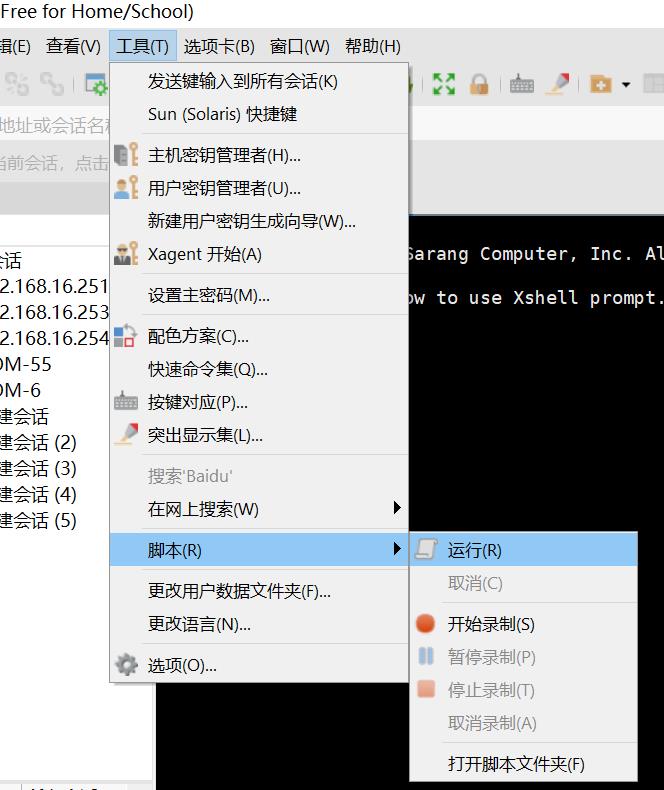xshell自动化脚本
Posted qlexcel
tags:
篇首语:本文由小常识网(cha138.com)小编为大家整理,主要介绍了xshell自动化脚本相关的知识,希望对你有一定的参考价值。
xshell具有脚本功能,可以实现很多自动化的操作。

从xshell的官方手册,可以知道xshell的脚本分为3类:

xsh.Session
下面的函数或变量在xshell会话中使用,使用的时候要指定会话一起使用,比如使用Sleep()函数,要这样使用:xsh.Session.Sleep(1000)。
函数
| 返回值 | 函数 | 参数 | 说明 |
|---|---|---|---|
| Void | Open(LPCTSTR lpszSession) | lpszSession:字符串,指Xshell会话路径或Xshell使用的URL类型。 | 打开新会话或URL。需要把 /s选项置于字符串的前端。 例如要打开A.xsh会话使用‘/s $PATH/A.xsh’ |
| Void | Close() | 关闭当前连接的会话。 | |
| Void | Sleep(long timeout) | Timeout:毫秒单位的时间值 | Xshell按照指定时间进行待机。 |
| Void | LogFilePath(LPCTSTR lpszNewFilePath) | lpszNewFilePath:包括路径在内的文件名 | 指定日志文件。 |
| void | StartLog() | 开始会话的日志记录。日志将被保存到LogFilePath()指定的路径。如果没有指定日志文件路径则使用默认路径。 | |
| void | StopLog() | 停止日志记录。 |
变量
| 名称 | 类型 | 说明 |
|---|---|---|
| Connected | BOOL | 检查当前会话是否连接。 |
| LocalAddress | BSTR | 导入本地地址。 |
| Path | BSTR | 导入当前会话文件的路径。 |
| RemoteAddress | BSTR | 导入远程地址。 |
| RemotePort | long | 导入远程端口号。 |
| Logging | BOOL | 检查当前会话是否记录日志。 |
| LogFilePath | BSTR | 保存为日志文件。 |
xsh.Screen
下面的函数和变量在处理xshell终端屏幕的时候使用,使用的时候要配合xsh.Screen一起使用,比如要使用Clear()函数,要这样使用:xsh.Screen.Clear
函数
| 返回值 | 函数 | 参数 | 说明 |
|---|---|---|---|
| void | Clear() | 清除终端屏幕。 | |
| void | Send(LPCTSTR lpszStrToSend) | lpszStrToSend:用户拟要发送的字符串 | 向终端发送消息。 |
| BSTR | Get(long nBegRow, long nBegCol, long nEndRow, long nEndCol) | nBegRow:终端的行起始位置 nBegCol:终端的列起始位置 nEndRow:终端的行末端位置 nEndCol:终端的列末端位置 | 读入终端规定区域的字符串并返回读取值。 |
| void | WaitForString(LPCTSTR lpszString) | lpszString:终端中打印的字符串 | 等待终端打印lpszString字符串。 |
| Long | WaitForStrings(VARIANT FAR* strArray, long nTimeout) | strArray:终端中打印的字符串 nTimeout:等候时间 返回值:发现的字符数 | 等待某消息直到超时。 |
变量
| 名称 | 类型 | 说明 |
|---|---|---|
| CurrentColumn | long | 返回当前列数。 |
| CurrentRow | long | 返回当前行数。 |
| Columns | long | 返回与终端的列宽相同的列数。 |
| Rows | long | 返回与终端的行高相同的行数。 |
| Synchronous | BOOL | 设置屏幕同步 (True:屏幕同步,false:屏幕不同步) |
xsh.Dialog
使用的时候要配合xsh.Dialog一起使用,比如要使用MsgBox()函数,要这样使用:xsh.Dialog.MsgBox()
函数
| 返回值 | 函数 | 参数 | 说明 |
|---|---|---|---|
| Long | MsgBox(LPCTSTR lpszMsg) | LpszMsg:想要发送的字符串 | 打开一个消息框 |
| string | Prompt(LPCTSTR lpszMessage, LPCTSTR lpszTitle, LPCTSTR lpszDefault, BOOL bHidden) | lpszMessage:在对话框上显示的字符串。 lpszTitle:在对话框标题栏显示的字符串。 lpszDefault:在对话框输入框中初始显示的字符串。 bHidden:如果设置为True,输入会被隐藏 (e.g. *****) | 作用:返回用户在对话框中的输入。 返回值:用户在对话框中的输入。 |
| int | MessageBox(LPCTSTR lpszMessage, LPCTSTR lpszTitle, int nType) | lpszMessage:在消息框中显示的字符串。 lpszTitle:在消息框标题栏显示的字符串。 nType:按钮类型,参考下面的表。 | 作用:按照用户选择的按钮类型显示消息框并返回相应的值。 返回值:参考下面的表。 |
按钮类型:
| 类型 | Button | 返回值 |
|---|---|---|
| 0 | OK | 1 |
| 1 | OK / Cancel | 1 / 2 |
| 2 | Abort / Retry / Ignore | 3 / 4 / 5 |
| 3 | Yes / No / Cancel | 6 / 7 / 2 |
| 4 | Yes / No | 6 / 7 |
| 5 | Retry / Cancel | 4 / 2 |
| 6 | Cancel / TryAgain / Continue | 2 / 10 / 11 |
实例
Sub Main
Dim hostname, username, password
hostname = xsh.Dialog.Prompt ("Insert Hostname", "Prompt Dialog", "hostname", 0)
username = xsh.Dialog.Prompt ("Username", "Prompt Dialog", "", 0)
password = xsh.Dialog.Prompt ("Password", "Prompt Dialog", "", 1)
if xsh.Dialog.MessageBox("Connect to " & hostname & " server", "MessageBox",1) = 1 then
xsh.Session.Open("ssh://" & username & ":" & password & "@" & hostname)
End If
End Sub
注:以下实例来自网上,仅供自己编程参考,不保证直接能用。
实例1
Sub main
xsh.Screen.Synchronous = True ' 使窗口显示与当前输出同步
xsh.Screen.WaitForString "Reboot now? (y/n)" ' 等待目标设备发回 "Reboot now? (y/n)" 字符串
xsh.Screen.Send "y" & VbCr ' 输入字符 y 并回车
End Sub
实例2
Sub Main
' *** Connect the session ***
xsh.Session.Open "ssh://192.168.1.17"
' "/s C:\\Users\\Administor\\AppData\\Roaming\\NetSarang\\Xshell\\Sessions\\example.xsh"
xsh.Screen.Synchronous = true
xsh.Screen.WaitForString "login: "
xsh.Screen.Send "username"
xsh.Screen.Send VbCr
xsh.Session.Sleep 100
xsh.Screen.WaitForString "Password: "
xsh.Screen.Send "password"
xsh.Screen.Send VbCr
xsh.Session.Sleep 100
' *** Wait for Prompt Message ***
xsh.Screen.WaitForString "username@password"
' *** Set File Format ***
Dim app, wb, ws
Set app= CreateObject("Excel.Application")
Set wb = app.Workbooks.Add
set ws = wb.Worksheets(1)
xsh.Session.LogFilePath = "c:\\example.log"
xsh.Session.StartLog
Dim waitStrs
waitStrs = Array(Chr(10), "username@password") ' make wait message as array
Dim row, screenrow, readline, itmes
row = 1
' *** Send Command ***
xsh.Screen.Send "cat /etc/passwd"
xsh.Screen.Send VbCr
xsh.Session.Sleep 100
Dim result
' *** Read Data and Save it as an EXCEL File ***
Do
While true
result = xsh.Screen.WaitForStrings(waitStrs, 1000)
If result = 2 Then
Exit Do
End If
screenrow = xsh.Screen.CurrentRow - 1
readline = xsh.Screen.Get(screenrow, 1, screenrow, 40)
items= Split(readline, ":", -1)
ws.Cells(row,1).Value = items(0)
ws.Cells(row,2).Value = items(2)
row = row + 1
Wend
Loop
wb.SaveAs("C:\\chart.xls") ' save file path
wb.Close
app.Quit
Set ws = nothing
Set wb = nothing
Set app = nothing
xsh.Screen.Synchronous = false
xsh.Session.StopLog
End Sub
实例3
Xshell打开多个session(会话)
Sub Main
Dim username, password
username = "用户名"
password = "密码"
Dim Hosts(主机名的个数减去1)
hosts(0) = "主机名1"
hosts(1) = " 主机名2 "
hosts(n-1) = " 主机名n"
For Each HostStr In Hosts
xsh.Session.Open ("ssh://" & username & ":" & password & "@" & HostStr)
xsh.Session.Sleep(50)
Next
End Sub
实例4
# import xsh.Session
# import xsh.Screen
# import xsh.Dialog
def get_current_row_info(num: int):
"""
获取终端当前行num个字符
"""
screenRow = xsh.Screen.CurrentRow
line = xsh.Screen.Get(screenRow, 1, screenRow, num)
return line
def Main():
# 打开一个已经存在的会话
# xsh.Session.Open("ssh://user:pass_word@192.168.31.52:22")
xsh.Session.Open("G:\\\\user\\\\Documents\\\\NetSarang Computer\\\\7\\\\Xshell\\\\Sessions\\\\192.168.31.52.xsh")
xsh.Screen.Synchronous = True
xsh.Session.Sleep(1000)
# 切换到root用户
xsh.Screen.Send("su root\\r")
xsh.Session.Sleep(100)
line = get_current_row_info(30)
if "Password" in line:
xsh.Screen.Send("paas_word\\n")
实例5
# import xsh.Session
# import xsh.Screen
# import xsh.Dialog
import re
def get_current_row_info(num: int):
"""
获取终端当前行num个字符
"""
screenRow = xsh.Screen.CurrentRow
line = xsh.Screen.Get(screenRow, 1, screenRow, num)
return line
def Main():
# 在一个存在的会话中执行
xsh.Screen.Synchronous = True
xsh.Session.Sleep(1000)
xsh.Screen.Send("ssh zzb@192.168.31.52\\r")
xsh.Session.Sleep(100)
# 当第一次登录时,会验证初始ssh连接
line = get_current_row_info(100)
if re.search("yes/no", line):
xsh.Screen.Send("yes\\r")
xsh.Session.Sleep(100)
# 终端出现提示输入密码时,输入密码
line = get_current_row_info(100)
if re.search("paasword", line, flags=re.I):
xsh.Screen.Send("yes\\r")
if "password" in line:
xsh.Screen.Send("paas_word\\r")
实例6
/* 测试函数 */
function test()
{
/* 发送echo 112233 > /tmp/testfile */
xsh.Screen.Send("echo 112233 > /tmp/testfile");
xsh.Screen.Send(String.fromCharCode(13));
/* 发送cat /tmp/testfile */
xsh.Screen.Send("cat /tmp/testfile");
xsh.Screen.Send(String.fromCharCode(13));
/* 字符串处理 */
var ScreenRow, ReadLine, Items;
/* 读取末行的40个字符 */
ScreenRow = xsh.Screen.CurrentRow - 1;
ReadLine = xsh.Screen.Get(ScreenRow, 1, ScreenRow, 40);
/* 如果读取到的字符不是112233 */
if(ReadLine != "112233")
{
/* 会话框打印实际的字符串 */
xsh.Dialog.MsgBox(ReadLine);
}
}
/* 主函数 */
function Main()
{
/* 打开会话,根据实际的会话路径修改 */
xsh.Session.Open("C:\\Users\\Administrator\\Documents\\NetSarang Computer\\6\\Xshell\\Sessions\\ubuntu.xsh");
xsh.Screen.Synchronous = true;
/* 开始记录日志 */
xsh.Session.LogFilePath = "C:\\Users\\Administrator\\Documents\\NetSarang Computer\\6\\Xshell\\Logs\\example.log";
xsh.Session.StartLog();
/* 等待输入start */
// xsh.Screen.WaitForString("start");
/* 发送rm -rf /tmp/testfile */
xsh.Screen.Send("rm -rf /tmp/testfile");
/* 发送回车 */
xsh.Screen.Send(String.fromCharCode(13));
/* 发送touch /tmp/testfile */
xsh.Screen.Send("touch /tmp/testfile");
xsh.Screen.Send(String.fromCharCode(13));
/* 测试100次 */
for(var i = 1; i < 100; i++)
{
test();
xsh.Session.Sleep(500);
}
/* 清屏 */
// xsh.Screen.Clear();
}
以上是关于xshell自动化脚本的主要内容,如果未能解决你的问题,请参考以下文章